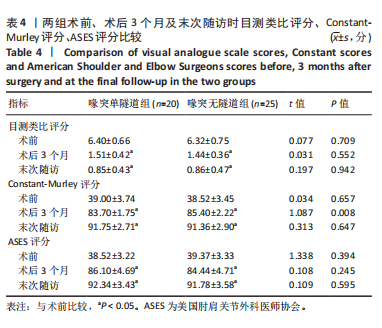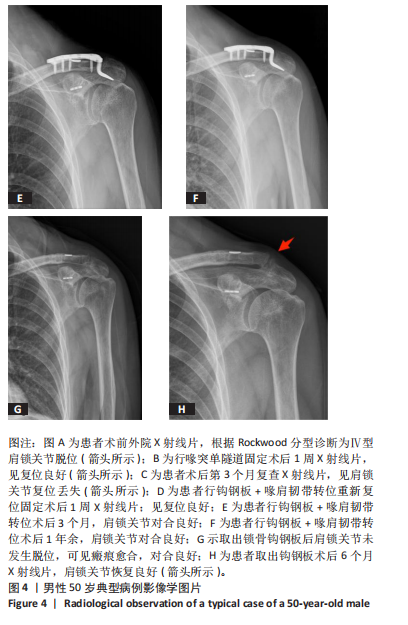[1] PENG L, ZHENG Y, CHEN S, et al. Single tunnel technique versus coracoid sling technique for arthroscopic treatment of acute acromioclavicular joint dislocation. Sci Rep. 2022;12(1):4244.
[2] SKJAKER SA, ENGER M, ENGEBRETSEN L, et al. Young men in sports are at highest risk of acromioclavicular joint injuries: a prospective cohort study. Knee Surg Sports Traumatol Arthrosc. 2021;29(7):2039-2045.
[3] OKEREKE I, ABDELFATAH E. Surgical Management of Acute Rockwood Grade III Acromioclavicular Joint Dislocations: A Systematic Review. Cureus. 2022;14(9):e28657.
[4] JEONG JY, CHUN YM. Treatment of acute high-grade acromioclavicular joint dislocation. Clin Shoulder Elb. 2020;23(3):159-165.
[5] COOK JB, KRUL KP. Challenges in Treating Acromioclavicular Separations: Current Concepts. J Am Acad Orthop Surg. 2018;26(19):669-677.
[6] 王增亮,赵力.Rockwood Ⅲ型肩锁关节脱位分型及治疗策略[J].中国组织工程研究,2018,22(35):5694-5699.
[7] GIAI VIA R, BOSCO F, GIUSTRA F, et al. Acute Rockwood type III ACJ dislocation: Conservative vs surgical approach. A systematic review and meta-analysis of current concepts in literature. Injury. 2022; 53(10):3094-3101.
[8] TAUBER M, HOFFELNER T, LEHMANN L, et al. Prospective Multicenter Randomized Controlled Trial of Surgical Versus Nonsurgical Treatment for Acute Rockwood Type 3 Acromioclavicular Injury. Orthop J Sports Med. 2023;11(8):23259671231190411.
[9] 刘镇煌,黄长明,范华强,等.肩锁关节脱位钩钢板固定的并发症与对策[J].中国矫形外科杂志,2023,31(2):111-116.
[10] AKAR B. The correlation between acromial osteolysis and acromion types in the treatment of acromioclavicular joint dislocation with hook plate. Medicine (Baltimore). 2022;101(43):e31632.
[11] XU D, LUO P, CHEN J, et al. Outcomes of surgery for acromioclavicular joint dislocation using different angled hook plates: a prospective study. Int Orthop. 2017;41(12):2605-2611.
[12] 季斌,冯萍,赵增斌,等.TightRope与钩钢板治疗肩锁关节脱位的比较[J].中国矫形外科杂志,2022,30(10):877-882.
[13] OH HS, KIM S, HYUN JH, et al. Effect of subacromial erosion shape on rotator cuff and clinical outcomes after hook plate fixation in type 5 acromioclavicular joint dislocations: a retrospective cohort study. BMC Musculoskelet Disord. 2022;23(1):42.
[14] LONGO UG, CIUFFREDA M, RIZZELLO G, et al. Surgical versus conservative management of Type III acromioclavicular dislocation: a systematic review. Br Med Bull. 2017;122(1):31-49.
[15] BARTH J, DUPARC F, ANDRIEU K, et al. Is coracoclavicular stabilisation alone sufficient for the endoscopic treatment of severe acromioclavicular joint dislocation (Rockwood types III, IV, and V)? Orthop Traumatol Surg Res. 2015;101(8 Suppl):S297-S303.
[16] HISLOP P, SAKATA K, ACKLAND DC, et al. Acromioclavicular Joint Stabilization: A Biomechanical Study of Bidirectional Stability and Strength. Orthop J Sports Med. 2019;7(4):2325967119836751.
[17] VERSTRAETE O, VAN TONGEL A, DE WILDE L, et al. Acromioclavicular reconstruction techniques after acromioclavicular joint injuries: A systematic review of biomechanical studies. Clin Biomech (Bristol, Avon). 2023;101:105847.
[18] OKI S, MATSUMURA N, IWAMOTO W, et al. The function of the acromioclavicular and coracoclavicular ligaments in shoulder motion: a whole-cadaver study. Am J Sports Med. 2012;40(11):2617-2626.
[19] GRANTHAM C, HECKMANN N, WANG L, et al. A biomechanical assessment of a novel double endobutton technique versus a coracoid cerclage sling for acromioclavicular and coracoclavicular injuries. Knee Surg Sports Traumatol Arthrosc. 2016;24(6):1918-1924.
[20] HISLOP P, SAKATA K, ACKLAND DC, et al. Acromioclavicular Joint Stabilization: A Biomechanical Study of Bidirectional Stability and Strength. Orthop J Sports Med. 2019;7(4):2325967119836751.
[21] 房燚,赵文志,潘德悦,等.肩锁关节脱位研究:如何达到解剖复位和持续性稳定及关节微动[J].中国组织工程研究,2020,24(5): 796-802.
[22] 胡安全,李哲,吴可沁.肩锁关节脱位患者带袢钢板与锁骨钩钢板治疗的效果及对肩峰撞击征发生率的影响对比[J].中国全科医学, 2021,24(S2):103-105+131.
[23] 何文江,黄小顺,刘传芳,等.微创双切口结合双带袢钢板固定技术治疗完全型肩锁关节脱位[J].中国医学创新,2017,14(7):20-23.
[24] VERSTRAETE O, VAN TONGEL A, DE WILDE L, et al. Acromioclavicular reconstruction techniques after acromioclavicular joint injuries: A systematic review of biomechanical studies. Clin Biomech (Bristol, Avon). 2023;101:105847.
[25] FLORES DV, GOES PK, GÓMEZ CM, et al. Imaging of the Acromioclavicular Joint: Anatomy, Function, Pathologic Features, and Treatment. Radiographics. 2020;40(5):1355-1382.
[26] XU J, LIU H, LU W, et al. A retrospective comparative study of arthroscopic fixation in acute Rockwood type IV acromioclavicular joint dislocation: single versus double paired Endobutton technique. BMC Musculoskelet Disord. 2018;19(1):170.
[27] 吴安平,徐高兵,谭海涛,等.关节镜下可调节袢板内固定治疗RockwoodⅢ型肩锁关节脱位[J].中国骨与关节损伤杂志,2022, 37(7):737-739.
[28] 张斌,郑伟,陈晨,等. 关节镜下TightRope系统固定与钩钢板内固定治疗急性肩锁关节脱位对比研究[J].中国现代医药杂志,2023, 25(2):57-60.
[29] 储淼,周建刚,蒋涛,等. TightRope钢板与锁骨钩钢板联合喙肩韧带转位治疗RockwoodⅢ型肩锁关节脱位的疗效比较[J]. 临床与病理杂志,2022,42(9):2213-2220.
[30] GERHARDT DC, VANDERWERF JD, RYLANDER LS, et al. Postoperative coracoid fracture after transcoracoid acromioclavicular joint reconstruction. J Shoulder Elbow Surg. 2011;20(5):e6-e10.
[31] KOH KH, SHON MS, CHOI NH, et al. Anatomic Tunnel Placement Is Not Feasible by Transclavicular-Transcoracoid Drilling Technique for Coracoclavicular Reconstruction: A Cadaveric Study. Arthroscopy. 2018;34(7):2012-2017.
[32] MILEWSKI MD, TOMPKINS M, GIUGALE JM, et al. Complications related to anatomic reconstruction of the coracoclavicular ligaments. Am J Sports Med. 2012;40(7):1628-1634. |





